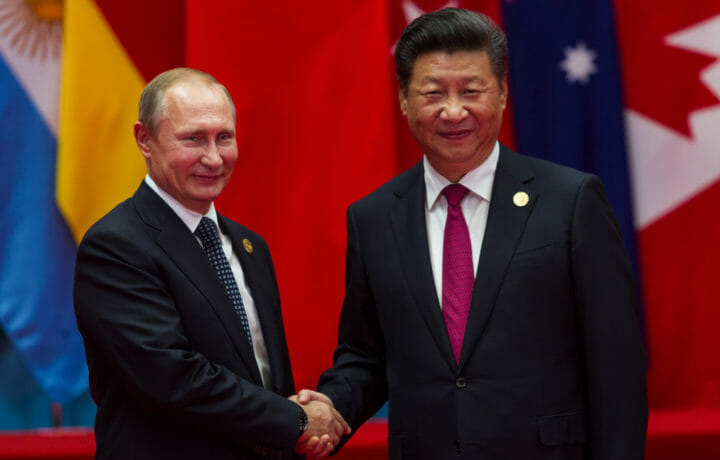Recently, President Joe Biden confirmed that Russia had used hypersonic missiles against targets in Ukraine.
“And if you’ll notice, (Russia has) just launched the hypersonic missile, because it’s the only thing that they can get through with absolute certainty,” Biden told reporters. “It’s a consequential weapon … it’s almost impossible to stop it. There’s a reason they’re using it.”
Even as the president hyped the capabilities of the hypersonic missiles, his own Secretary of Defense downplayed the use of the air-launched Kinzhal missile.
“I would not see it as a game changer,” Secretary Lloyd Austin had told CBS News’ Face the Nation.
Even if Secretary Austin doesn’t see the Kh-47M2 Kinzhal as a game changer, it is still a significant weapon. It is also just one of Russia’s hypersonic missiles currently in service, and it can fly at a reported 10 times the speed of sound and has a range of up to 2,000 kilometers or about 1,250 miles. Due to speed and capability to maneuver in flight, it is extremely hard to counter. It has been seen as a threat to critical land infrastructure, but also to large warships, notably aircraft carriers.
The missiles can also be carried on Tu-22M3 bombers and MiG-31K fighters, which can further extend the Kinzhal’s range. Both aircraft have been deployed to Hmeymim Air Base, also known as Khmeimim Air Base, in Syria. It is currently Russia’s only military facility outside of the former Soviet Union.
“China is also developing hypersonic weapons, and in 2021 tested a hypersonic glide missile with countermeasure capabilities – signaling that as part of its development it is attempting to create systems which can overcome missile defense systems, though it is unknown how effective these systems are,” William Davies, associate analyst for aerospace, defense and security at London-based international data analytics firm Global Data, told ClearanceJobs.
Potential Game Changers
Hypersonic weapons are just one of the advanced platforms that near peer adversaries, including Russia and China, are seeking to develop. These top rivals are increasing investment in the fields of cyber, space, nuclear, and artificial intelligence (AI).
China has been leveraging emerging technologies to challenge U.S. interests in the Indo-Pacific.
According to the DoD’s annual report on Chinese military power, Beijing increasingly believes that emerging technologies will shape and increase the speed of warfare, meaning future military success will require forces that are “mechanized, informatized, and intelligentized” – the latter describing a concept of future warfare based on disruptive technology, notably AI.
This includes intelligent technologies, systems, and operational concepts such as “attrition warfare by intelligent swarms, cross-domain mobile warfare, AI-based space confrontation, and cognitive control operations” – which could also facilitate information processing and decision-making on the battlefield.
“China has a stated aim of becoming a world leader in AI by 2030, and specifically to raise the value of its domestic AI industry to $150 billion,” said Global Data’s Davies. “Whilst AI is likely to become more advanced by 2030, achieving advanced AI use in the military sphere is difficult to achieve, and it remains to be seen if the state will be able to realize these capabilities.”
Maintaining America’s Edge
Earlier this month, the Department of Defense’s (DoD’s) Undersecretary of Defense for Research and Engineering Heidi Shyu warned that the U.S. must invest in developing those new technologies to maintain its edge in future combat situations.
“We cannot afford a leveling of technology advantage,” Shyu said in an address at the McAleese defense conference, and called for the U.S. to sustain its technological edge by heavily investing in education and R&D – specifically those at federal and university research centers, as well as in the commercial defense sector.
“It is imperative for the department to nurture early research in emerging technologies to prevent technological surprise,” she continued. “We must leverage critical state-of-the-art commercial technology where rapid advancements are trying to accelerate our military capabilities.”
There are number of technologies that the DoD has a particular interest in acquiring. According to Shyu these include biotech to detect and avoid future pandemics; quantum computing capabilities to solve analytical problems as quickly and precisely as possible; light, temperature-resistant armor; 5G communications technology; secure AI for unmanned vehicles; space architecture; domestic microelectronics manufacturing; and of course the hypersonic missiles.
“In the future, now emerging technologies, like Quantum computing, are likely to play significant roles in securing and hardening businesses and infrastructures against cyber attacks,” explained technology industry analyst Charles King of Pund-IT.
“Quantum is a nascent technology which has not been realized by any nation, China has made investments into the technology including the development of a quantum communication link between Beijing and Shanghai,” added Davies. “Whilst China’s investment signals they view the technology as important, they are likely some way from being able to utilize quantum technology for military use.”
There is very much an arms race to develop quantum computing.
“I also expect that continuing technology evolution will increase the use of computational tools used for weapons guidance systems and battlefield strategizing,” King told ClearanceJobs.
Even as there are the efforts to develop better technology, it won’t overcome a failed execution of a battle plan or over confidence – as noted by Russia’s invasion of Ukraine.
King noted, “a stark lesson of this invasion is how even vastly superior forces can falter and fail due to practical mistakes, like poor planning and ineffectual supply chains.”




